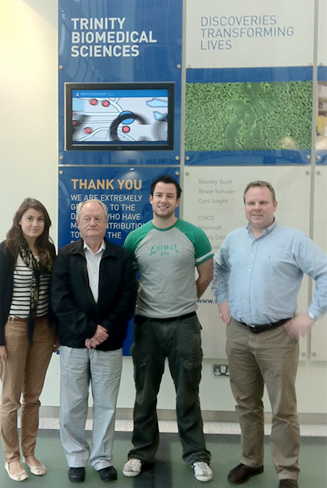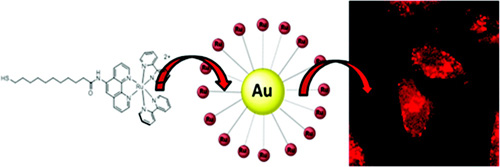New Research Highlights Live Cancer Cells Using Glowing Nanoparticles
Posted on: 20 October 2011
New collaborative research by scientists at Trinity College Dublin has resulted in the development of a new approach to visualising live cancerous cells using luminescent metal based nanotechnology. Led by Professor in Chemistry, Thorfinnur Gunnlaugsson and Professor of Biochemistry, Clive Williams, the research forms part of a collaborative effort between the School of Chemistry and the School of Biochemistry and Immunology to develop novel delivery methods and alternative approaches to cancer therapies. The research article was published recently in the Journal of the American Chemical Society and represents the first piece of published research from the new Trinity Biomedical Sciences Institute.
Ruthenium (II) polypyridyl complexes are a class of compounds that display rich photophysics and photochemistry. The research paper investigates the synthesis of Ru(II)-polypyridyl stabilised, luminescent gold nanoparticles (AuNPs). These structures bind to DNA with some enhancement in their luminescent properties and undergo rapid cellular uptake, being localised within the cell cytoplasm and nucleus within a few hours. These findings could lead to advances in current cancer diagnostic and treatment efforts and will form the basis of a project that will look to exploit the advantageous properties of such gold-ruthenium based nano-systems for understanding cellular function and behaviour.

Authors of the study, Kim Orange, Professor Clive Williams, Dr Rob Elmes and Professor Thorfinnur Gunnlaugsson.
Speaking about the research, Professor Thorfinnur Gunnlaugsson said: “This research provides a proof of principle but we now need to progress this project further. We have the synthetic and spectroscopic expertise in the School of Chemistry as well as within the infrastructure of Trinity’s nanoscience institute, CRANN, which allows us to modify and tune the properties of such nanoparticle systems. While within the School of Biochemistry and Immunology we have the instrumentation and experience to evaluate their potential in various biological applications. By simply changing their outer shell, these gold-ruthenium nano-conjugates should provide advances in areas such as fluorescent biomarkers, drug delivery systems and also in photo-activated cancer therapies.”
Commenting on how this multidisciplinary approach to research can bring about new advances and added benefits for future applications of such technologies, Professor Clive Williams said: “The completion of the Trinity Biomedical Sciences Institute allows for more facile delivery of such quality pharmaceutical and biotechnological research. This collaboration has already resulted in our research being published in internationally renowned scientific journals and with both research groups now being housed in one purpose-built facility we hope that collaborations of this nature will become more commonplace here at Trinity College.”
The full research paper, entitled ‘Luminescent Ruthenium(II) Polypyridyl Functionalized Gold Nanoparticles: Their DNA Binding Abilities and Application As Cellular Imaging Agents’, can be viewed online.

